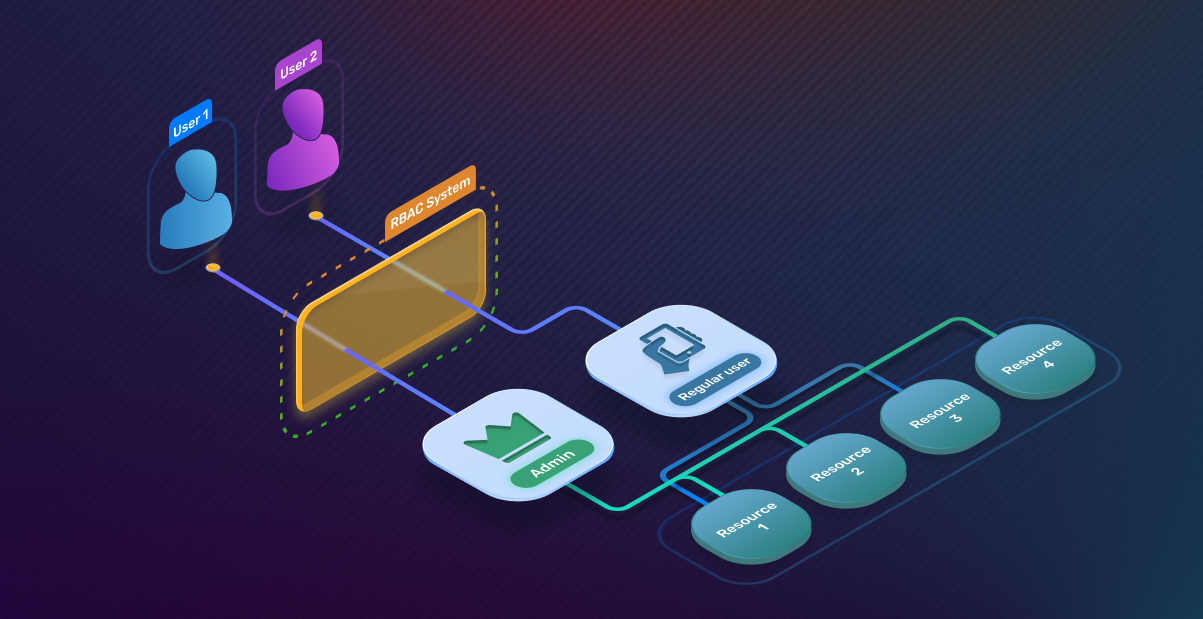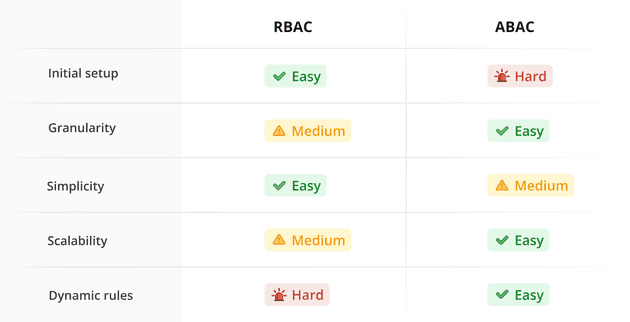In today’s digital age, securing sensitive information and sensitive data is more critical than ever. Among the various methods of preventing unauthorized access, Role-Based Access Control (RBAC) has emerged as a popular and effective approach.
RBAC is an access control mechanism built around the concept of roles and privileges. Instead of assigning permissions directly to each user, RBAC assigns permissions to roles, and users are then assigned to these roles. This makes assigning a user access and access management easier and less time consuming for your apps, especially in large organizations
What is RBAC?
Role-Based Access Control (RBAC) is an approach to restricting system access to authorized users based on their roles within an organization. Instead of granting permissions to each user individually, RBAC assigns permissions to predefined roles, and users are then assigned to these roles.
How does RBAC work?
At its core, RBAC operates on three primary components:
- Roles: A role is a collection of permissions that define what actions a user assigned to that role can perform. An organization can have different roles with different permissions assigned to each role. Examples of roles include Admin, Editor, and Viewer.
- Permissions: Permissions are the rights granted to a role to perform certain actions on system resources. For example, an Admin role might have permissions to create, edit, and delete content, but a Viewer would only have permission to view content.
- Users: Users are individuals who have access to the system. Each user is assigned one or more roles, which dictate the level of access they have.
Let’s consider an example of a content management system (CMS) with the following roles:
- Administrator: Has full control over the system, including user management, content creation, and system settings.
- Editor: Can create, edit, and delete content but cannot manage users or change system settings.
- Viewer: Can only view content and has no permissions to modify it.
In this scenario, when a new user joins the organization as a content creator, they are assigned the Editor role. This assignment automatically grants them the necessary permissions to create and edit content without requiring individual permission settings.
Real-world use cases for Role-Based Access Control
RBAC is mainly designed to be used in systems that have a large number of users and there is a varying amount of access that each user can have. It is effective in making access management easier in situations where access can be grouped based on the position of a user in the organization. Here are some common use cases where a role-based access control system can be beneficial:
- Financial Systems: Consider the example of your bank, you as an end-user have limited access to the banking systems and can only deposit/withdraw money and can view your own balance. The bank teller has some more access and for example can view the balances of other end-users as well. The bank manager then has even more access and can perform some operations on every bank account in their branch and so on. In such a system there can be defined roles such as User, Teller, Manager, Department Head etc and each of these roles can be assigned specific permissions based on what they should be able to do.
- Information Technology: IT based organizations are a very common use case for RBAC. You often have roles such as Developers, QA, Admins and End-Users with each having their own access to the organization’s systems. For example you may have a repository on Github and based on what role an employee has they may be given access to that repository.
- Education: In a university you have students who can access and update their own information and assignments, professors who can view every student’s assignments and grade them as long as they belong to their class, registrar who can view and update every student’s information and so on.
- Retail: In a retail store you have sales executives that can pull information from the inventory and maybe assign discounts, managers who can configure discounts and update pricing of an item, inventory managers who can add and remove items from stock and so on.
- Healthcare: Doctors can retrieve information about a patient and assign specific instructions, Nurses can view instructions to follow, Admin staff can perform various tasks within the hospital system itself and so on.
Role-Based Access Control (RBAC) vs Attribute-Based Access Control (ABAC)
In the realm of access control, two prominent models are Role-Based Access Control (RBAC) and Attribute-Based Access Control (ABAC). While both aim to secure resources and manage user permissions, they differ significantly in their approaches and applicability.
RBAC assigns permissions based on user roles within an organization. Each role has a set of permissions, and users are assigned to these roles, granting them the corresponding permissions. Permissions are typically static and predefined for each role, making the system straightforward to implement and manage.
ABAC, on the other hand, grants access based on attributes associated with users, resources, and the environment. Attributes can include user attributes (e.g., department, job title), resource attributes (e.g., document classification), and environmental attributes (e.g., time of day, location). Permissions are evaluated dynamically based on the attributes and access policies defined by the organization.
Here are some key differences between the two:
- Flexibility: RBAC is more rigid, as access is determined by predefined roles and their associated permissions. Changes in user permissions typically require role modifications or reassignment. ABAC is highly flexible, allowing for fine-grained access control based on a wide range of attributes. Access policies can dynamically adjust to changing conditions and contexts.
- Complexity: RBAC is easier to implement and manage due to its straightforward role-permission assignments. Ideal for organizations with stable and well-defined roles. ABAC is more complex to set up and maintain, as it requires defining and managing numerous attributes and policies. Suitable for organizations with dynamic environments and diverse access requirements.
Benefits of using Role-Based Access Control
Here are some of the benefits gained by using RBAC:
Simplified Management of Permissions
One of the most significant benefits of RBAC is the simplification of permission management. By grouping permissions into roles, administrators can assign these roles to users rather than dealing with individual permission settings. This streamlined process reduces the administrative overhead and makes it easier to manage access rights.
Enhances Security
RBAC supports the principle of least privilege, which ensures that users only have the permissions necessary to perform their job functions. By assigning roles with specific permissions, organizations can minimize the risk of unauthorized access and potential security breaches.
Compliance
Many industries are subject to stringent regulatory requirements regarding data access and security. RBAC helps organizations comply with these regulations by providing a structured and auditable framework for managing permissions. Roles and their associated permissions can be documented and reviewed, making it easier to demonstrate compliance during audits and assessments.
Reduced risk of human error
Manual management of individual permissions is prone to errors, such as granting excessive permissions or overlooking critical access needs. RBAC reduces the risk of such errors by centralizing permission management within defined roles. This centralization ensures consistency in permission assignments and reduces the likelihood of misconfigurations
Separation of duties
RBAC facilitates the implementation of separation of duties (SoD) policies, which are essential for preventing conflicts of interest and fraud. By assigning distinct roles to different users, organizations can ensure that no single individual has excessive control over critical processes.
Disadvantages of using Role-Based Access Control (RBAC)
While Role-Based Access Control (RBAC) offers numerous benefits, it also has its limitations and challenges. Here are some of the key downsides of using RBAC:
Rigidity in Dynamic Environments
RBAC is often criticized for its lack of flexibility in dynamic environments where roles and responsibilities frequently change. Since permissions are tied to roles, any change in job functions or access requirements necessitates updates to the roles themselves. This rigidity can lead to delays in granting necessary access and can make it difficult to adapt quickly to evolving business needs.
Role Explosion
One of the significant challenges with RBAC is the potential for role explosion. As organizations grow and diversify, the number of roles can proliferate to accommodate various combinations of permissions. This can lead to an overwhelming number of roles, making management cumbersome and defeating the purpose of simplified access control.
Maintenance Overhead
Maintaining an RBAC system requires ongoing effort. Roles need to be regularly reviewed and updated to reflect changes in the organization’s structure and access requirements. Ensuring that users are assigned the correct roles and that permissions remain appropriate involves continuous monitoring and administration. This overhead becomes more tedious to manage when there is role hierarchy.
Limited Flexibility
While RBAC provides a straightforward approach to access control, it can lack the granularity needed for more nuanced access decisions. In situations where access needs to be determined based on multiple attributes or contextual factors (such as time of day, location, or specific project involvement), RBAC may fall short.
Key things to consider when building Role-Based Access Control (RBAC)
Thorough Requirements Analysis
Before implementing RBAC, conduct a detailed analysis of your organization’s access control requirements. Identify the various roles within the organization, the specific permissions needed for each role, and the resources these roles will access. This analysis should involve input from different departments to ensure comprehensive coverage of all access needs.
Clear and Granular Role Definition
Create roles that are well-defined and granular enough to meet the specific needs of your organization. Avoid overly broad roles that grant excessive permissions and roles that are too narrow, which can lead to role explosion. Strive for a balance that provides necessary access while maintaining security and manageability.
Regularly Review and Audit Roles
Regularly review and audit the roles and permissions within your RBAC system. Conduct periodic access reviews to verify that users have appropriate permissions and that roles remain relevant to the organization’s current structure and needs. Remove or modify roles that are no longer necessary or have become outdated.
Implement Separation of Duties
Design roles to enforce separation of duties (SoD) policies, ensuring that critical tasks require multiple users to complete. This practice helps prevent conflicts of interest and reduces the risk of fraud and errors. Clearly define and document SoD requirements and regularly audit role assignments to ensure compliance.
Monitor and Adapt
Continuously monitor the effectiveness of your RBAC system and be prepared to adapt as organizational needs change. Use monitoring tools to track access patterns, detect anomalies, and identify areas for improvement. Regularly solicit feedback from users and administrators to ensure the system remains effective and user-friendly.
Bonus: Using Role-Based Access Control (RBAC) with SuperTokens
SuperTokens provides User Roles feature which allows you to:
- Create roles and associate them with an array of permissions.
- Associate an array of roles to each user.
- Fetch a list of roles and permissions for a user.
- Save the roles and permissions in a session to access them efficiently on the frontend and backend APIs.
- Guard frontend routes and backend APIs to only allow access if a user has a certain role or permission.
Using our built in recipes and feature sets, you can set up RBAC in under 45 minutes. You can read our launch blog or visit the official documentation to get started.
Conclusion
By understanding the strengths and limitations of RBAC and following best practices, organizations can leverage this access control model to protect their resources, support compliance, and improve operational efficiency. As the landscape of information security continues to evolve, RBAC remains a foundational tool for managing access and safeguarding sensitive information in a wide range of industries.


